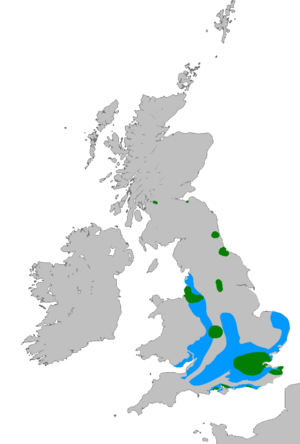Feral parakeets in Great Britain facts for kids

Wild parakeets in Great Britain are birds that live in the wild but are not originally from this country. They are an introduced species, meaning they were brought here by people. These birds are mostly rose-ringed parakeets (Psittacula krameri). They are a type of bird that does not migrate, and they originally came from Africa and the Indian subcontinent. No one is completely sure how these birds first arrived in Britain. However, most experts believe they came from birds that escaped from cages or aviaries.
Most of Britain's wild parakeets live in the suburbs around London and the Home Counties in South East England. Because of this, people sometimes call them "Kingston parakeets" or "Twickenham parakeets." This is because they are often seen in the London areas of Kingston upon Thames and Twickenham. These parakeets have babies very quickly and have spread beyond these areas. Flocks have been seen in other parts of Britain, like a group of 20 to 30 birds in Victoria Park, Glasgow. Other wild parakeet groups also live in and around other cities in Europe.
How Did They Get Here?

It's a bit of a mystery how the parakeet population first started and grew so well in England. Many theories exist, but most suggest that a pair or more of parakeets escaped or were set free sometime in the mid-1990s. This is when the first widespread photos of the birds started appearing.
Here are some of the popular stories about how they might have arrived:
- Some say parakeets escaped from Isleworth Studios in 1951. This was a film studio used for the movie The African Queen.
- Another idea is that parakeets escaped from damaged bird cages during the Great Storm of 1987.
- A fun story suggests that Jimi Hendrix released a pair of parakeets in Carnaby Street, London, in the 1960s.
- There are also reports that several parakeets escaped from a pet shop in Sunbury-on-Thames in 1970.
Even with these interesting stories about movies and musicians, most bird experts think the first birds probably escaped from aviaries before 1971. The parakeets in Britain are thought to be a mix of two types from Asia: P.k. borealis and P.k. manillensis.
Parakeet Population in Britain
Even though parakeets became much more noticeable and their numbers grew a lot in the late 1900s and early 2000s, people have seen escaped parakeets in Britain since the 1800s. The first time someone officially recorded seeing one was in 1855 in Norfolk. Parakeets were also seen in Dulwich in 1893 and Brixton in 1894.

Over the years, parakeets kept escaping from captivity. However, their populations usually died out until 1969. That year, a group of parakeets in London finally started having babies and surviving on their own. They began in Croydon and then spread to Wraysbury, Bromley, and Esher. Their numbers stayed very low until the mid-1990s, when the population suddenly started growing very fast.
In 1983, there were about 500 parakeets. By 1996, there were 1,500. In 2002, there were 5,800 in the London area. The last official count in 2012 found about 32,000 parakeets in London!
British parakeets are most common in the south-east of England. This includes the London suburbs, Surrey, Kent, and Sussex. Parakeet groups have also been seen further north in cities like Liverpool, Oxford, Birmingham, Manchester, Sheffield, and Edinburgh.
Because their numbers are growing and they are spreading quickly, it's hard to get an exact count of parakeets in Britain. The Royal Society for the Protection of Birds (RSPB) estimates there are around 8,600 breeding pairs in Britain. Other scientific counts from 2012 suggested there were about 32,000 birds in total.
Impact on Nature
Experts like Dr. Hazel Jackson, who studies invasive species, are concerned about how the growing number of parakeets might affect nature in south-east England. Research has shown that parakeets compete with native British birds and bats for food and places to build nests.
Even though parakeets are not aggressive, their noisy behavior and large size can scare away smaller birds. They often crowd small bird feeders, which means less food for other birds. This can upset the natural balance of local ecosystems.
Some people compare this problem to how grey squirrels affected red squirrels when they were introduced. However, British parakeets do have natural predators. Bird experts have noticed more birds of prey in London, such as Eurasian sparrowhawks, peregrine falcons, and hobbies, hunting parakeets.
In some countries, like Israel, parakeets are considered a pest. Large groups of parakeets can cause a lot of damage to crops. There is some worry that the fast-growing parakeet population in Britain could have unexpected effects on the environment. In 2009, the government wildlife group Natural England added wild parakeets to a list of species that can be legally culled (controlled) without special permission. Wild monk parakeets are also on this list. However, in March 2021, the Department for Environment, Food and Rural Affairs said there are no plans to cull the rose-ringed parakeet population in the UK.
Images for kids



